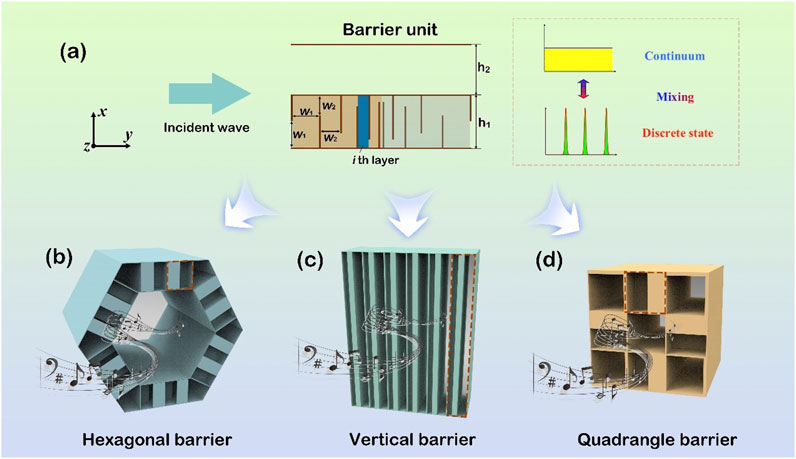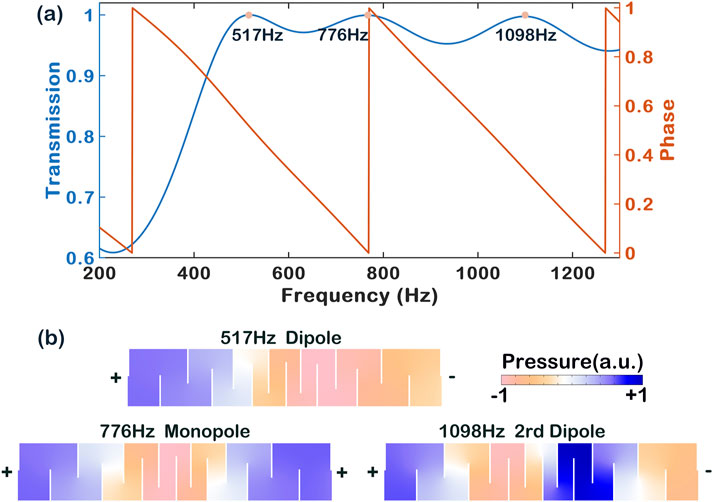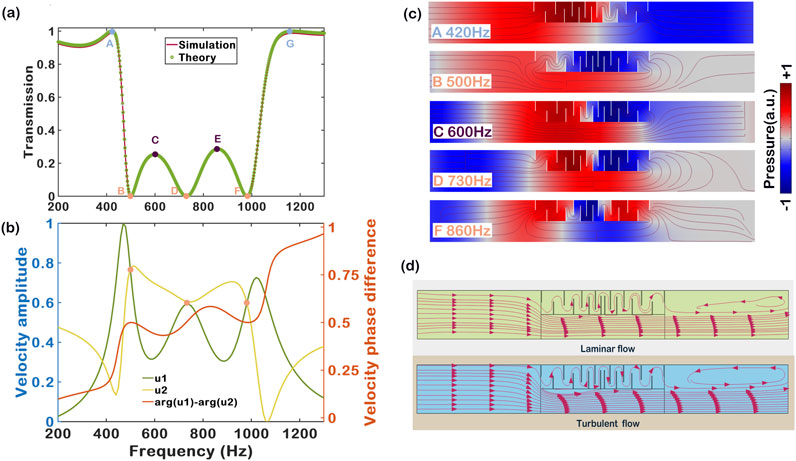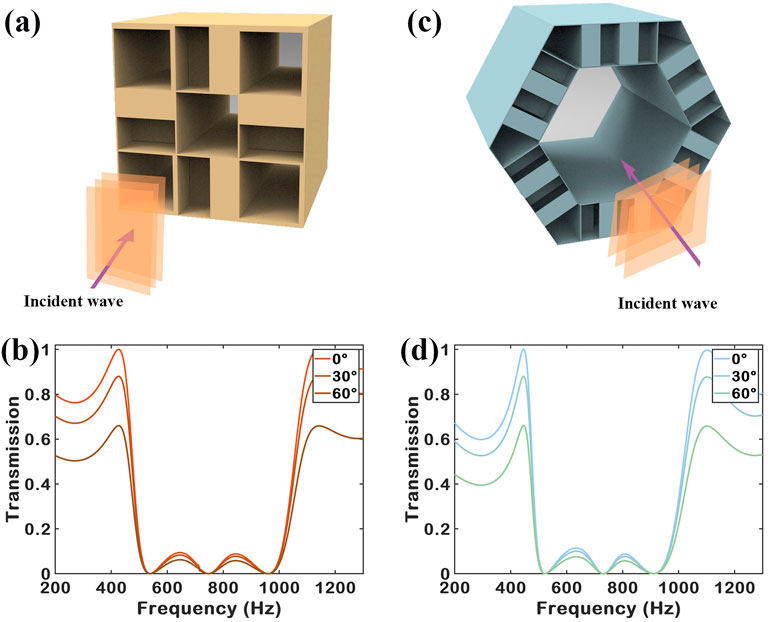- 1Nanjing Research Institute of Electronics Technology, Nanjing, China
- 2The Unit 93209 of People’s Liberation Army, Beijing, China
The introduction of Fano resonance into acoustic metamaterials provides the possibility for simultaneous airborne sound insulation and high-efficiency ventilation, while the ultranarrow Fano line shape and limited shape configurations restrict the expansion to practical applications. In this work, we theoretically propose and demonstrate a broadband low-frequency ventilation acoustic chiral barrier with arbitrary geometrical configurations, where consecutive multiple Fano resonances (CMFRs) generate destructive interference in the range of 479–1,032 Hz. The barrier unit with a binary planar design is composed of the chiral space-coiling tunnel and hollow pipe, providing the discrete resonant and continuum states for Fano resonant system. By means of judiciously tuning the coupling of the above-mentioned two states, multi-order Fano resonances manifest as low transmission in a wide frequency range. Good agreement between simulated, theoretical, and measured results validates the effectiveness of the proposed barrier in the broad low-frequency range, in which the laminar and turbulent flow models reveal the high air-permeability of our barrier. Thanks to the unit planar profile, we can flexibly customize the arbitrary geometrical configurations of the barrier to extend into three-dimensional (3D) space for practical noise reduction applications. Our research makes it possible to construct ventilation artificial metastructure with a flexible manner for broadband sound attenuation.
Introduction
In the field of acoustic metamaterials (AMs), there remains a significant challenge for simultaneous air-borne sound-proofing and airflow permeability [1–3]. In the last decade, AMs based on local resonance have witnessed tremendous progress in ventilation barriers, while the ventilation areas of the structures have been sacrificed to mount silencing metamaterial components. To break the restriction, broadband acoustic barriers based on Fano resonances [4–13] has been introduced in airborne soundproof engineering [14–26] for its high-efficiency ventilation which come from its physical essence of the coupling of unimpeded pathways [27, 28]. However, conventional Fano resonance exhibits as an ultra-sharp asymmetric line [29], which is induced by the equal strength of the discrete resonant state and a smooth continuum state in background media [30], extremely limiting the related applications in actual wideband scenarios with complex frequency components. In pursuit of a broadband sound-proofing yet airflow-permeating performance, the mechanism of acoustic consecutive Fano resonances was presented to broaden the sound insulating bandwidth [31–36]. For example, Xu et al. proposed a low-frequency double-helix meta-silencer to realize broadband sound attenuation and high ventilation. Similar work [36] have emerged recently, however, their bandwidth is still smaller than half an octave due to the fact that the transmission peaks of Fano resonances intuitively limits the superposition of more higher-order Fano resonances [30]. To obtain more broadband performance in a Fano-based ventilation design, the higher-order Fano resonances must come into play. In addition, the previous works [20, 21, 37] in the field of sound insulating metamaterials pay more attention to the development of single metastructure, ignoring the requirements of complex structural configurations in actual application scenarios. Therefore, the mechanism for realizing broader soundproofing frequency range in acoustic Fano systems with simplicity and flexibility so far remains elusive.
In this work, we theoretically propose and numerically demonstrate a broadband low-frequency acoustic chiral barrier enabled by consecutive multiple Fano resonances, dramatically decreasing the incident energy from 479 to 1,032 Hz while maintaining efficient ventilation. The barrier with a planar profile is composed of a binary design of the chiral space coiling tunnel and hollow pipe. Due to reasonable superposition of multi-order Fano resonance modes, the response strength from the discrete and continuum states keeps quasi-balanced, generating high-quality destructive interference in a broadband. Good agreement between the simulated, analytical, and experimental results verifies the effectiveness of our proposal. Our work paves a road for low-frequency airborne soundproof structures in the presence of ventilation.
As shown in Figure 1A, we consider the case of the planar profile of the barrier unit, which schematically illustrates the proposed broadband ventilation chiral barrier composed of an opened pathway and a labyrinthine channel. The incident sound waves are vertically incident along the y-axis from upstream, the incident waves are partitioned into two parts at the upstream interface of the unit and travel forward in the opened region and the space-coiling path separately, and then flow jointly towards the downstream side of the unit. To address impedance mismatch arising from the space-coiling geometry, we strategically employ a variable cross-section space-coiling channel to ensure high transmission efficiency. This design maintains a constant effective refractive index, facilitating Fabry-Perot resonances [38] and enabling the formation of desired resonant modes that support discrete resonant modes for Fano resonance. The term “chiral” refers to the unique geometric configuration of our acoustic meta-unit, which exhibits handedness in its design. This handedness is achieved through the specific arrangement of the space-coiling tunnel and hollow pipe within the unit. The introduction of chirality in our design allows for the manipulation of acoustic waves to achieve enhanced impedance matching and broadband noise reduction. In our proposed meta-unit, formed by combining these two kinds of components together, the interference between the resonant scattering of discrete states and the background scattering of continuous states leads to the desired acoustic performance. The hollow pipe unit, which always allows a unity transmission as long as this unit has a subwavelength size, plays the role of the continuum in Fano resonance. This configuration supports the formation of broadband Fano resonances through the constructive and destructive interference between discrete and continuous states.

Figure 1. Schematic illustration for the designed broadband ventilation barrier. (a) The details of the chiral barrier unit and its geometry dimensions on the x-y plane. (b–d) The ventilation barrier based on the designed unit with different geometrical configurations.
Specifically, the height of the space-coiling channel and the open channel along the y-axis is
As shown in Figure 2a, the space-coiling channel keeps high averaged transmission coefficient more than 0.92 in the range of 400–1,200 Hz due to variable cross-section design, which maintain the subsequent high-quality interference with the open channel. The space-coiling channel exhibits a linear phase profile [39], which is indicative of its broadband non-dispersive property. Additionally, it supports consecutive resonances: dipolar resonances at 517 Hz and 1,098 Hz, and a monopolar resonance at 776 Hz. These resonances are characterized by distinct radiation patterns. Specifically, for the dipolar resonances, sound radiates strongly along the axis connecting the two poles, with minimal radiation perpendicular to this axis. In contrast, the monopolar resonance at 776 Hz exhibits a radiation pattern with sound pressure being uniform in both directions. The effective refractive index of the space-coiling channel can be obtained from the simulated results by

Figure 2. (a) Transmission and phase of the chiral coiling-space unit. (b) Sound-pressure distributions of the coiling-space unit at the dipole, monopole, and 2nd dipole modes.
To study acoustic wave transmission and reflection behavior of the acoustic barrier, we introduce a simplified acoustic model of the chiral unit, where the actual space-coiling channel is replaced with a straightened effective channel filled with effective fluid. The effective fluid is characterized by constitutive parameters (
where
The average pressure fields at the inlet and outlet of the effective and ventilation channels, which are presented sequentially in Equations 4–7
Considering the channels are deep-subwavelength, the pressure field inside the channels can be estimated by the fundamental mode,
where
Substituting Equations 8, 9 into Equations (1–3) leads to the following set of equations in a matrix form for determining the normalized volume velocities at the inlet/outlet of the channels which is labeled as Equation 10:
where
The transmission and reflection fields are estimated from Equation 1 by considering
respectively. As a result, the transmission and reflection coefficients are readily obtained as Equation 13
To demonstrate the broadband insulating performance of CMFRs, we judiciously choose an effective unit cell with h1 = 37.22 mm, h2 = 37.22 mm,

Figure 3. (a) Theoretically predicted and numerically calculated transmission of Fano resonant profile. (b) The amplitude spectra of the normalized volume velocities u at the outlet of the channels are shown with olive and purple lines, respectively. The phase differences of the volume velocities are also shown with the orange line corresponding to the rightward y-axis. (c) Simulated sound-field distributions at peak, middle weak-peak and three dips, where the white lines represent the local velocity streamlines, and the color maps illustrate the acoustic pressure distributions. (d) Numerical analysis results of Laminar and turbulent flow for the ventilation barrier.
The broadband sound attenuation from another point of view, can be considered as the weakly coupling between the discrete resonant and continuum states. To quantitatively interpret the coupling, we further plot the phase and magnitude of
To vividly illustrate the sound reduction performance enabled by the proposed barrier design, we present the representative numerical simulation results depicting the distributions of sound pressure and particle velocity streamlines in Figure 3c. At the transmission peak frequencies (such as 420 Hz), complete acoustic transmission can be observed on the output side. However, at the transmission dip frequencies (500 Hz, 730 Hz, and 860 Hz), total reflection occurs at the input side of the metamaterial, resulting in nearly zero energy transmission. The simulated sound field patterns reveal interference fringes on the output side, arising from the superposition of acoustic waves propagating through the helical channel and the central channel. Notably, at the intermediate weak peak frequencies of 600 Hz, a remarkably diminished amplitude is observed, indicating consistent and effective sound blocking across the entire middle frequency range.
To investigate the air permeability of the proposed barrier, we employ both laminar and turbulent flow simulations to model the air flow through the structure, which are illustrated in Figure 3d. The distinction between the laminar and turbulent flow models lies in the Reynolds number, which represents the ratio of inertial forces to viscous forces within the fluid flow. For the laminar flow model, the Reynolds number is set to 100, while for the turbulent flow model, the Reynolds number is set to 4,000. These values are chosen to represent typical flow regimes where the fluid experiences a balance between inertial and viscous forces. The boundary conditions are set to no-slip at the walls, ensuring that the fluid velocity at the walls is zero. The simulation results demonstrate that the barrier design exhibits excellent ventilation performance under both flow regimes. Air can freely flow through the coiling-space and open channels. The key difference is that in the laminar flow scenario, only minor vortices form at the exit of the coiling-space, whereas in the turbulent flow case, with higher flow velocities, more pronounced vortex shedding occurs at the same location. It is noteworthy that despite laminar or turbulent flows, the proposed barrier architecture exhibits a remarkable ability to facilitate efficient airflow transmission, which contribute to the simultaneous realization of sound attenuation and ventilation functionalities.
In practical noise control scenarios, the complexity of the environment and the presence of various boundary constraints pose significant challenges for achieving efficient broadband noise insulation while maintaining adequate air permeability. Thanks to the flexibility and versatility, we further investigate the performance of the ACMFRs-based sound barrier in various geometrical configurations (Figures 4a,c), including hexagonal and square arrangements. As show in Figures 4b,d, we can observe that these configurations consistently maintain almost 80% noise insulation bandwidth, highly consistent with the unit case, demonstrating the robustness this mechanism. Additionally, we investigated the oblique incidence transmission characteristics of the aforementioned barrier configurations. Owing to their subwavelength features and structural symmetry, these barriers exhibit exceptional angle-insensitivity, maintaining outstanding noise attenuation even at large incidence angles. Considering various geometric configurations and incident angles, the CMFRs mechanism demonstrating superior robustness in achieving broadband noise attenuation and high air permeability, laying a solid foundation for its implementation in practical noise control scenarios such as industrial production and architectural environments.

Figure 4. (a,b) Schematic of the 3D acoustic barrier with quadrilateral configuration based on the proposed units and numerically obtained transmission spectrum. (c,d) Schematic of the 3D acoustic barrier with hexagonal configuration based on the proposed units and numerically obtained transmission spectrum.
The experiment is conducted to verify broadband silencing performance of the proposed enhanced Fano-type acoustic silencer. In our experiments, as depicted in Figure 5a, we set up a test environment to measure the transmission coefficients across a range of frequencies. The sound transmission coefficients of a 3D-printed sample are measured in the laboratory-made impedance tube, utilizing the four-load method. The results, shown in Figure 5b alongside the numerical predictions, reveal a strong correlation between the experimental and simulated data. This congruence underscores the effectiveness of our design in blocking incident waves across a broad frequency band. However, we did observe that the experimental transmission spectrum is marginally lower than the numerical predictions. We attribute these discrepancies primarily to two factors: first, the weak absorption caused by viscous energy dissipation within the material, which was not accounted for in our simulations; and second, discrepancies arising from sample fabrication errors. These factors can introduce variability and deviations in the actual performance compared to the idealized model.

Figure 5. (a) Schematics of the experimental setup. (b) The frequency dependences on measured and simulated transmission coefficients.
In conclusion, we have theoretically proposed and demonstrated a low-frequency acoustic chiral barrier that achieves consecutive multiple Fano resonances for simultaneous broadband noise reduction and ventilation. The barrier unit composed of chiral space-coiling tunnel and hollow pipes supports the broadband weakly coupling between the discrete resonant and continuum states. Through judiciously tuning the coupling of above two states, multiple order Fano resonances generate broadband sound attenuation in the range of 479–1,032 Hz. Good agreement between the simulated, theoretical, and experimental results validate the broadband sound reduction over this frequency range. Notably, the flow simulations indicate that the Fano-based barrier can maintain an efficient airflow transmission, presenting a highly ventilated noise reduction solution. This work realizes a flexible, ventilated, and broadband noise barrier using consecutive Fano resonances, enabling low-frequency airborne sound insulation under ventilation.
Data availability statement
The raw data supporting the conclusions of this article will be made available by the authors, without undue reservation.
Author contributions
Z-xX: Data curation, Investigation, Software, Validation, Writing – original draft. YF: Conceptualization, Project administration, Resources, Supervision, Writing – review and editing. X-pW: Project administration, Resources, Supervision, Writing – review and editing.
Funding
The author(s) declare that no financial support was received for the research and/or publication of this article.
Conflict of interest
The authors declare that the research was conducted in the absence of any commercial or financial relationships that could be construed as a potential conflict of interest.
Generative AI statement
The author(s) declare that no Generative AI was used in the creation of this manuscript.
Publisher’s note
All claims expressed in this article are solely those of the authors and do not necessarily represent those of their affiliated organizations, or those of the publisher, the editors and the reviewers. Any product that may be evaluated in this article, or claim that may be made by its manufacturer, is not guaranteed or endorsed by the publisher.
References
1. Dong R, Sun M, Mo F, Mao D, Wang X, Li Y. Recent advances in acoustic ventilation barriers. J Phys D: Appl Phys (2021) 54:403002. doi:10.1088/1361-6463/ac1228
2. Ma G, Yang M, Xiao S, Yang Z, Sheng P. Acoustic metasurface with hybrid resonances. Nat Mater (2014) 13:873–8. doi:10.1038/nmat3994
3. Xu Z-x., Gao H, Ding Y-j., Yang J, Liang B, Cheng J-c. Topology-optimized omnidirectional broadband acoustic ventilation barrier. Phys Rev Appl (2020) 14:054016.
4. Attaran A, Emami SD, Soltanian MRK, Penny R, Behbahani F, Harun SW, et al. Circuit model of Fano resonance on tetramers, pentamers, and broken symmetry pentamers. Plasmonics (2014) 9:1303–13. doi:10.1007/s11468-014-9743-y
5. Bärnthaler A, Rotter S, Libisch F, Burgdörfer J, Gehler S, Kuhl U, et al. Probing decoherence through Fano resonances. Phys Rev Lett (2010) 105(4):056801. doi:10.1103/physrevlett.105.056801
6. Fan PY, Yu ZF, Fan SH, Brongersma ML. Optical Fano resonance of an individual semiconductor nanostructure. Nat Mater (2014) 13:471–5. doi:10.1038/nmat3927
7. Fano U. Effects Of Configuration Interaction On Intensities And Phase Shifts. Phys Rev (1961) 124:1866–78. doi:10.1103/physrev.124.1866
8. Johnson AC, Marcus CM, Hanson MP, Gossard AC. Coulomb-modified Fano resonance in a one-lead quantum dot. Phys Rev Lett (2004) 93(4):106803. doi:10.1103/physrevlett.93.106803
9. Miroshnichenko AE, Flach S, Kivshar YS. Fano resonances in nanoscale structures. Rev Mod Phys (2010) 82:2257–98. doi:10.1103/revmodphys.82.2257
10. Qiang ZX, Yang HJ, Chuwongin S, Zhao DY, Ma ZQ, Zhou WD. Design of Fano broadband reflectors on SOI. Ieee Photon Technology Lett (2010) 22:1108–10. doi:10.1109/lpt.2010.2050471
11. Shafiei F, Monticone F, Le KQ, Liu XX, Hartseld T, Alù A, et al. A subwavelength plasmonic metamolecule exhibiting magnetic-based optical Fano resonance. Nat Nanotechnology (2013) 8:95–9. doi:10.1038/nnano.2012.249
12. Wang YF, Liao L, Hu T, Luo S, Wu L, Wang J, et al. Exciton-polariton Fano resonance driven by second harmonic generation. Phys Rev Lett (2017) 118(5):063602. doi:10.1103/physrevlett.118.063602
13. Wu CH, Khanikaev AB, Shvets G. Broadband slow light metamaterial based on a double-continuum Fano resonance. Phys Rev Lett (2011) 106(4):107403. doi:10.1103/physrevlett.106.107403
14. Chen Z, Fan L, Zhang SY, Zhang H, Li XJ, Ding J. An open-structure sound insulator against low-frequency and wide-band acoustic waves. Appl Phys Express (2015) 8(4):107301. doi:10.7567/apex.8.107301
15. Choy YS, Huang LX. Experimental studies of a drumlike silencer. J Acoust Soc America (2002) 112:2026–35. doi:10.1121/1.1508779
16. Dong R, Mao D, Wang X, Li Y. Ultrabroadband acoustic ventilation barriers via hybrid-functional metasurfaces. Phys Rev Appl (2021) 15:024044. doi:10.1103/physrevapplied.15.024044
17. Huang S, Fang X, Wang X, Assouar B, Cheng Q, Li Y. Acoustic perfect absorbers via Helmholtz resonators with embedded apertures. J Acoust Soc Am (2019) 145:254–62. doi:10.1121/1.5087128
18. Krasikova M, Krasikov S, Melnikov A, Baloshin Y, Marburg S, Powell DA, et al. Metahouse: noise-insulating chamber based on periodic structures. Adv Mater Tech (2022) 8. doi:10.1002/admt.202200711
19. Liu TW, Chan CT, Wu RT. Deep-Learning-based acoustic metamaterial design for attenuating structure-borne noise in auditory frequency bands. Materials (Basel) (2023) 16:1879. doi:10.3390/ma16051879
20. Meng Y, Romero-García V, Gabard G, Groby JP, Bricault C, Goudé S. Subwavelength broadband perfect absorption for unidimensional open-duct problems. Adv Mater Tech (2023) 8. doi:10.1002/admt.202201909
21. Tang Y, Liang B, Lin S. Broadband ventilated meta-barrier based on the synergy of mode superposition and consecutive Fano resonances. J Acoust Soc Am (2022) 152:2412–8. doi:10.1121/10.0014911
22. Wu H-W, Yin Y-Q, Sheng Z-Q, Li Y, Qi D-X, Peng R-W. Multiband omnidirectional ventilated acoustic barriers based on localized acoustic rainbow trapping. Phys Rev Appl (2021) 15:054033. doi:10.1103/physrevapplied.15.054033
23. Xiang L, Wang G, Zhu C, Shi M, Hu J, Luo G. Ventilation barrier with space-coiling channels of varying cross-section for broadband sound insulation. Appl Acoust (2022) 201:109110.
24. Xu ZX, Gao H, Ding YJ, Yang J, Liang B, Cheng JC. Topology-optimized omnidirectional broadband acoustic ventilation barrier. Phys Rev Appl (2020) 14(8):054016. doi:10.1103/physrevapplied.14.054016
25. Zhu XF, Li K, Zhang P, Zhu J, Zhang JT, Tian C, et al. Implementation of dispersion-free slow acoustic wave propagation and phase engineering with helical-structured metamaterials. Nat Commun (2016) 7(7):11731. doi:10.1038/ncomms11731
26. Zhu Y, Dong R, Mao D, Wang X, Li Y, Ventilating Metasurfaces N. Nonlocal ventilating metasurfaces. Phys Rev Appl (2023) 19:014067. doi:10.1103/physrevapplied.19.014067
27. Ghaffarivardavagh R, Nikolajczyk J, Anderson S, Zhang X. Ultra-open acoustic metamaterial silencer based on Fano-like interference. Phys Rev B (2019) 99(10):024302.
28. Zhang HL, Zhu YF, Liang B, Yang J, Yang J, Cheng JC. Omnidirectional ventilated acoustic barrier. Appl Phys Lett (2017) 111(4):203502. doi:10.1063/1.4993891
29. Limonov MF, Rybin MV, Poddubny AN, Kivshar YS. Fano resonances in photonics. Nat Photon (2017) 11:543–54. doi:10.1038/nphoton.2017.142
30. Xu Z-x., Qiu W-j., Cheng Z-q., Yang J, Liang B, Cheng J-c. Broadband ventilated sound insulation based on acoustic consecutive multiple Fano resonances. Phys Rev Appl (2024) 21:044049. doi:10.1103/physrevapplied.21.044049
31. Nguyen HQ, Wu Q, Chen H, Chen JJ, Yu YK, Tracy S, et al. A Fano-based acoustic metamaterial for ultra-broadband sound barriers. Proc R Soc A: Math Phys Eng Sci (2021) 477. doi:10.1098/rspa.2021.0024
32. Shi J, Liu C, Liu X, Lai Y. Ventilative meta-window with broadband low-frequency acoustic insulation. J Appl Phys (2021) 129. doi:10.1063/5.0042384
33. Sun M, Fang X, Mao D, Wang X, Li Y. Broadband acoustic ventilation barriers. Phys Rev Appl (2020) 13:044028. doi:10.1103/physrevapplied.13.044028
34. Wu H, Zhang H, Hao C. Reconfigurable spiral underwater sound-absorbing metasurfaces. Extreme Mech Lett (2021) 47:101361. doi:10.1016/j.eml.2021.101361
35. Xiang L, Wang G, Zhu C, Shi M, Hu J, Luo G. Ventilation barrier with space-coiling channels of varying cross-section for broadband sound insulation. Appl Acoust (2022) 201:109110. doi:10.1016/j.apacoust.2022.109110
36. Xu Z-x., Zheng B, Yang J, Liang B, Cheng J-c. Machine-learning-assisted acoustic consecutive Fano resonances: application to a tunable broadband low-frequency metasilencer. Phys Rev Appl (2021) 16:044020. doi:10.1103/physrevapplied.16.044020
37. Liu C, Shi J, Zhao W, Zhou X, Ma C, Peng R, et al. Three-dimensional soundproof acoustic metacage. Phys Rev Lett (2021) 127:084301. doi:10.1103/physrevlett.127.084301
38. Liang ZX, Li JS. Extreme acoustic metamaterial by coiling up space. Phys Rev Lett (2012) 108(4):114301. doi:10.1103/physrevlett.108.114301
39. Kumar S, Lee HP. Labyrinthine acoustic metastructures enabling broadband sound absorption and ventilation. Appl Phys Lett (2020) 116. doi:10.1063/5.0004520
40. Li Y, Qi S, Assouar MB. Theory of metascreen-based acoustic passive phased array. New J Phys (2016) 18:043024. doi:10.1088/1367-2630/18/4/043024
Keywords: acoustic, metamateials, silencer, fano resonance, broadband insulating
Citation: Xu Z-x, Fang Y and Wang X-p (2025) Enhanced fano-type broadband acoustic ventilated silencer with arbitrary geometrical configurations. Front. Phys. 13:1586858. doi: 10.3389/fphy.2025.1586858
Received: 03 March 2025; Accepted: 15 May 2025;
Published: 30 May 2025.
Edited by:
Xue Jiang, Fudan University, ChinaCopyright © 2025 Xu, Fang and Wang. This is an open-access article distributed under the terms of the Creative Commons Attribution License (CC BY). The use, distribution or reproduction in other forums is permitted, provided the original author(s) and the copyright owner(s) are credited and that the original publication in this journal is cited, in accordance with accepted academic practice. No use, distribution or reproduction is permitted which does not comply with these terms.
*Correspondence: Yu Fang, ZmFuZ3l1aHVzdEAxNjMuY29t
 Zi-xiang Xu
Zi-xiang Xu Yu Fang1*
Yu Fang1*